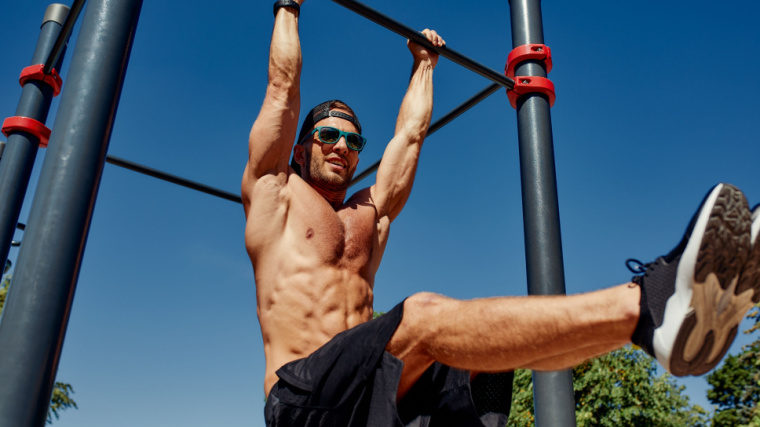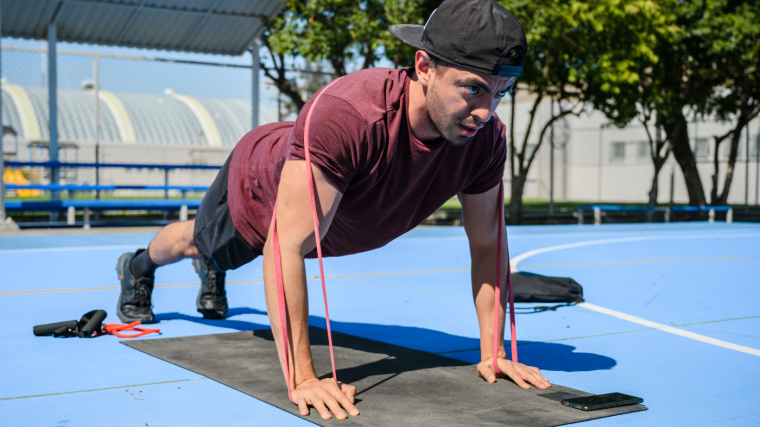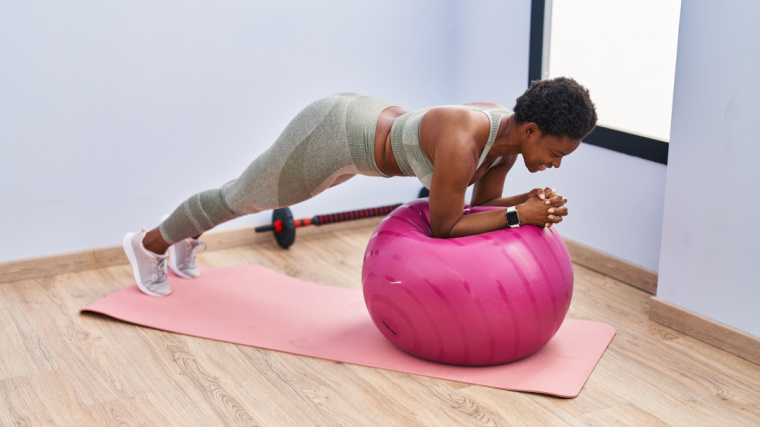If you got a bunch of aesthetically-focused gym goers in a room and asked them to rank their prized muscle groups, chances are that a six-pack will be fairly high on people’s lists. In pursuit of a chiseled core, athletes have been known to go hard. For the sake of sculpting a defined midsection, some will train their abs every single day.
But are high-volume ab workouts with little recovery time the best way to build abdominal muscles? How often should you work out your abs specifically, especially if your core is already recovering from heavy deadlifts and squats? While those strength-focused barbell exercises on their own won’t get you the six-pack you might be seeking, you might be wondering if working out your abs super often will eat into your core recovery for big lifts.

The ideal training frequency for ab workouts is pretty well established — you’ve just got to learn the ins and outs of recovery and accommodate as needed according to your skills and goals. Here’s how to make the time you need to crush your ab exercises without eating into recovery from your bigger lifts.
- How Often Should You Train Your Abs?
- The Anatomy of Your Abs
- How to Approach Ab Training
- Try These Three Basic Ab Exercises
- Try These Advanced Ab Exercises
- Frequently Asked Questions
How Often Should You Train Your Abs?
When it comes to ab training, research suggests that more isn’t necessarily better. In at least one study, three days of weekly abdominal training didn’t elicit significantly better endurance than one day of training per week. (1) This is backed up by subsequent studies that didn’t find much of a growth difference across study groups whose abs were directly trained on multiple days each week. (2)
And while frequency is less important than overall training volume — meaning that if you keep the overall training volume the same, it matters less how often you train each week — you probably don’t want to head into a heavy deadlift session with sore abs. Both Murphy and Higgins advise their clients to train their abs multiple days per week, but no more than three times.
“People should [typically] train their abs directly two to three times per week,” Higgin tells BarBend. “This allows for adequate stimulation as well as recovery, which is essential for muscle growth and strength gains.”

[Read More: Build a Titanic Torso with These Bodybuilding Chest & Back Workouts]
At the same time, every athlete is different, with their unique skills, life experiences, and goals in the gym. So while a few times a week (but no more than three direct ab sessions) may be a great match for most athletes, it won’t be the same for everyone.
“The frequency of training one’s abs has no cookie-cutter answer,” Murphy explains. “Many individuals have weak low backs from sit-down jobs and should not partake in heavy spinal flexion programs. On the other hand, surfers are in spinal extension often and should train abs daily to keep a strong neutral spine position.”
Research suggests that performing between eight and 16 sets per week, with an intensity that approaches hitting muscle failure within six to 20+ reps per set, is often sufficient to stimulate hypertrophy — regardless of how often or when you’re training in the week. (3) So whenever you’re tackling your ab training, be sure to approach failure for maximum growth.
The Anatomy of Your Abs
While it is common to think of your abdominals as a collective group, your midsection comprises several distinct core muscles with separate functions. If you want to develop well-proportioned ab muscles, a well-rounded bodybuilding ab workout should target each of these muscle groups.
The Abs You Can See
- Rectus Abdominis: This is the entirety of the visible muscle that makes up the six-pack region of muscles, from the upper abs to the lower abs. These are what people commonly reference when they talk about how to get abs.
- External Obliques: These rotational muscles run along the side of the midsection and serve to brace and frame the more prominent muscles in the center of your stomach.
The Abs You Can’t See
- Transverse Abdominis: This is a solid layer of muscle residing beneath your rectus abdominis and external obliques. While not clearly visible, it is essential to the creation of a strong core.
- Internal Obliques: This is a cluster of muscle fibers that sits beneath the external obliques and above the transverse abdominis. They contract in the opposite direction as the external obliques during torso rotations.
You’ll be including your lower back in the mix pretty heavily, too. But when you’re focusing on that six-pack and thinking about your abs, you’re likely wanting to target the abs you can see.
How to Approach Ab Training
Even if you’ve identified the ideal training volume for your core exercises, you can’t train your abs haphazardly and expect the sort of muscle growth you’re longing for. If you want to build muscle, see visible abs, and enjoy a matching level of core strength, there are a few training guidelines you’ll want to abide by.
Incorporate Variety
“To work the different muscle groups in the abdomen,” Higgins advises, “include a mix of exercises for the rectus abdominis, obliques, and transverse abdominis.”
[Read More: Exercises for CrossFit Beginners to Learn to Build a Strong Base]
Because the entire midsection consists of a series of different muscle groups, you’ll need to train all of them if you wish to maximize the development of the entire region.
Add Resistance
Higgins explains that unweighted crunches and planks just won’t build the kind of muscles you might be seeking: “Like any other muscle, the abs will respond to resistance, so incorporating weights or resistance bands can be beneficial.”

[Read More: What Are Workout Splits? Top 3 Most Effective Routines]
Abdominals can be trained for muscle hypertrophy just like any other set of muscles. If you desire large and well-developed abs that stick out, adding resistance to your exercises can help you achieve your objective.
Focus On Form
Don’t feel the need to crank out endless, mindless reps with terrible form. In fact, don’t. “The best approach to training abs is one of quality over quantity,” Higgins says. “It’s crucial to perform each exercise with proper form to engage the abs correctly and prevent injury.”
Taking your abs through their full range of motion is critical if you want them to achieve a full, well-rounded look from top to bottom and side to side.
Don’t Forget About Nutrition
“Abs are made in the kitchen,” Higgins reminds us, “so a balanced diet is crucial to reduce body fat and make the abs visible.”
[Read More: Best Protein Powders]
No matter how many sets of hanging leg raises you do, the brilliance of your core will remain concealed if you have layers of unaddressed body fat. Total-body resistance training, cardio exercises, and a balanced approach to nutrition can all contribute to shedding body fat.
If you’re aiming to lower your body fat significantly enough to see your six-pack, you’ll want to ensure that you’re getting all the nutrients you need even as you sustain a small caloric deficit. In order to make sure that any weight loss is sustainable, you’ll always have to give yourself enough fuel for your body and mind to both stay healthy.
To help you figure out how to adjust your macros — that’s your intake of protein, carbs, and fats — when you’re aiming to show off that six-pack, check out BarBend’s macros calculator.
Macronutrient Calculator
Don’t Get Fancy
You don’t need to reinvent the proverbial wheel. “Don’t get too fancy when training the abdominals,” Murphy says. “Spinal flexion is the key. The cue I like to use with clients is to move their rib cage toward their hips.”
Despite all of the exercises you can do for the abdominals, the basic elements are the same. The act of spinal flexion moves your rib cage toward your hips, causing a muscle-challenging contraction in your abdominals. Nearly all rectus abdominis training methods have this in common.
Change Your Tactics
“After achieving a low body fat percentage, if your goal is to make the abs pop, start using cable and band resistance with your spinal flexion exercises,” Murphy advises.

[Read More: Best Post-Workout Supplements]
Even if your abs are visible, there is still more work to be done if you want them to protrude. Changing your ab workout can help you accentuate certain features of your abs to create the look you want.
Train Your Lower Back
Don’t neglect your back if you want a stronger set of abs. “On a weekly basis, counter your spinal flexion exercises with spinal extension exercises,” Murphy suggests. “Creating a strong neutral spine [can] keep the injury cycle away.”
To reduce the potential for muscle imbalances in your midsection, engage in regular extension-based lower back exercises. This will help you to retain an ideal posture and also help reduce the likelihood of causing an injury due to overtraining your abs.
Alter Your Tempo
Your cadence is important, so don’t blaze through your reps to get done as quickly as possible. “Perform different rep tempos when training abs,” Murphy advises. “This can range from slow, five-second reps and holds to one-second controlled reps.”
[Read More: The Best Full-Body Bodybuilding Workout for Beginner to Advanced Lifters]
Conducting your ab exercises to different tempos can help you isolate your abs and feel the extent of the work they’re doing. Holding the contraction at the peak of spinal flexion also helps maximize the work of your abs as you squeeze every last ounce of effort out of them.
Try These Three Basic Ab Exercises
If you’re looking for three excellent ab-developers that require little-to-no home exercise equipment, these three suggestions from Higgins have you covered. These movements will help you craft a well-developed midsection that is also instilled with functional strength that can assist you during big barbell exercises like squats, deadlifts, and overhead presses.
You’ll be rotating, resisting extension, and engaging in some serious flexion. This is a solid combination for starting to build the basics of your ab training.
Plank
Why Do It: “They engage the entire core and improve postural support,” Higgins explains.
How to Do It: Place your body into a push-up position and contract your midsection to maintain the stability of that posture. Hold that position for the prescribed time.
Sets and Reps: Two sets of 30 to 60 seconds.
[Go in Depth: Simple Yet Effective — Here’s How to Do the Plank]
Hanging Leg Raise
Why Do It: “These are great for the lower abs and also engage the upper body,” Higgins says.
How to Do It: Suspend your body from a bar in a pull-up position. Contract at your midsection to elevate your legs and feet in the direction of your chin. Try to keep your legs as straight as possible. Return your legs to their starting position.
Sets and Reps: Three sets of eight to 15 reps.
[Go in Depth: How to Do Hanging Leg Raises for a Rock Solid Core]
Russian Twist
Why Do It: “This exercise targets the obliques and helps in developing rotational strength, which is beneficial for overall core stability,” Higgins tells BarBend.
How To Do It: While holding a dumbbell or weight plate in your hands, lie on the ground with your feet on the floor and your knees bent as if you were going to perform a crunch. Contract your abdominals to raise your head, neck, and back off the ground. Rotate your body from side to side without allowing your back to touch the ground.
Sets and Reps: Three sets of 15 to 20 reps.
[Go in Depth: Turn Your Core Training Up a Notch With the Russian Twist]
Try These Advanced Ab Exercises
If you’re interested in adding variety to your ab training, Murphy suggests that you incorporate resistance cables and stability balls. He prescribes supersets that blend weighted abdominal exercises with bodyweight exercises.
[Read More: Everything You Need to Know to Build Your First Workout Program]
Athletes aiming to up the ante on traditional crunches can use both weights and cables to help bring their muscles toward failure. By focusing on similar movement patterns with unique challenges, you’ll be able to push yourself toward muscle failure more efficiently, potentially increasing your hypertrophy potential.
While these moves all focus on flexion, they’re helpful for crafting a very particular physique. For athletes aspiring to be on a competitive physique stage, these can come in especially handy. “These exercises won’t bulk your waist, which makes them an aesthetic winner,” said Murphy. “They truly isolate the abs, and pop them straight out against the skin.”
Superset #1: Kneeling Cable Crunches and Stability Ball Crunches
How to Do Kneeling Cable Crunches: Kneel in front of the cable machine with the triceps rope in your hands and anchored to a high, overhead position. While keeping your hands at the level of the top of your head, contract your abs and bend forward to drive the rope down to the floor. Return to the starting position.
How to Do Stability Ball Crunches: Lie on a stability ball with your feet on the floor, and with your back relaxed and resting against the ball. Contract your abs to raise your back and allow your rib cage to shift toward your hips. Return to the starting position.
Sets and Reps: 15 reps of kneeling cable crunches, followed immediately by 30 reps of stability ball crunches. Repeat four times with 60 to 90 seconds between each set.
Superset #2: Prone Cable Half-Ball Crunches and V-Ups
How to Do Prone Cable Half-Ball Crunches: With the triceps rope in your hands and anchored at a low level, lie down with your back on top of a half-stability ball. Bend your knees, allow them to shift outward, and place the bottoms of your feet together. Contract your abdomen to bring your ribcage up and forward. Return to the starting position.
How to Do V-Ups: Lie flat on the ground with your legs extended, and extend your arms straight back along the ground as if you were holding them overhead. While keeping your arms and legs straight, contract your core to raise both your legs and upper body off the ground. Bring your arms up and forward and reach for your feet as if you are attempting to touch your toes. Return to the starting position.
Sets and Reps: 15 reps of prone cable half-ball crunches, followed immediately by 30 reps of V-ups. Repeat four times with 60 to 90 seconds between each set.
Quality Over Quantity
While there is often a tendency to want to train your most visible or cherished body parts the most often, your abs benefit from rest and recovery just like any other set of muscles.
Remember, your abs play a secondary role in many other resistance exercises, so it’s virtually impossible to go an entire training session without training them. This is all the more reason to treat them to a day off. When gauging how often to work out your abs, go for at least once per week — but most people will want to avoid training them directly more than three times a week.
Frequently Asked Questions
If you still have questions about how often you should train your abdominal region, we’ve got all the answers you need right here.
The ideal frequency of abdominal training is somewhat dependent on your individual needs. According to study results, as long as your overall volume is maintained, there is very little difference in abs that are trained one day per week or three days per week. (1) As such, the general guideline is that abs should be directly trained at least once per week, and no more than three times per week.
To develop six-pack abs, you will need to combine your abdominal training with a low body fat percentage. Resistance training, cardiovascular exercise, a caloric deficit, and a high metabolism can all contribute to a low body fat percentage.
The best way to train your abs varies by the specific abdominal group, and also by your strength capabilities and goals. (3) Traditional crunches and planks score very highly for beneficial muscle activity across simple exercises. Conversely, hanging leg raises are extremely beneficial for total-core engagement, but require significant strength in other muscle groups to be performed effectively. (4)
References
- Juan-Recio C, López-Vivancos A, Moya M, Sarabia JM, Vera-Garcia FJ. Short-term effect of crunch exercise frequency on abdominal muscle endurance. J Sports Med Phys Fitness. 2015 Apr;55(4):280-9.
- Schoenfeld BJ, Grgic J, Krieger J. How many times per week should a muscle be trained to maximize muscle hypertrophy? A systematic review and meta-analysis of studies examining the effects of resistance training frequency. J Sports Sci. 2019 Jun;37(11):1286-1295.
- Oliva-Lozano JM, Muyor JM. Core Muscle Activity During Physical Fitness Exercises: A Systematic Review. Int J Environ Res Public Health. 2020 Jun 16;17(12):4306.
- McGill S, Andersen J, Cannon J. Muscle activity and spine load during anterior chain whole body linkage exercises: the body saw, hanging leg raise and walkout from a push-up. J Sports Sci. 2015;33(4):419-26.
Featured Image: gpointstudio / Shutterstock